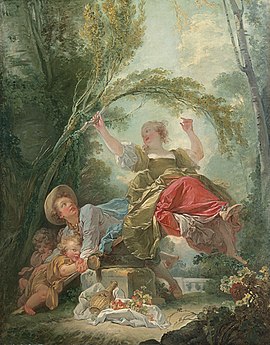The See-Saw (Fragonard, Madrid)
| The See-Saw | |
|---|---|
 | |
| Artist | Jean-Honoré Fragonard |
| Year | c. 1750−1752 |
| Medium | oil on canvas |
| Dimensions | 120 cm × 94.5 cm (47 in × 37.2 in) |
| Location | Thyssen-Bornemisza Museum, Madrid |
The See-Saw is an oil-on-canvas painting by French Rococo artist Jean-Honoré Fragonard, created c.1750–1752 during the artist's early career. It is currently in the Thyssen-Bornemisza Museum in Madrid. The painting forms a pair with another Fragonard work entitled Blind Man's Bluff.[1] Blind Man's Bluff focuses on courtship while The See-Saw, and the metaphor of the rocking motion of the seesaw, suggests the relationship has been consummated.[2][3]
The See-Saw depicts young children playing with a seesaw in a forest grove. It is seen as an important precedent to Fragonard's masterpiece The Swing.[4]
See also
References
- ^ "Blind-Man's Buff". toledomuseum.org. Archived from the original on 4 March 2016. Retrieved 4 September 2018.
- ^ "Jean-Honore Fragonard: Blindman's Bluff". Boston College. Archived from the original on 21 March 2014. Retrieved 11 June 2013.
- ^ The Art Story
- ^ "The See-Saw". Museo Nacional Thyssen-Bornemisza. Retrieved July 25, 2019.
